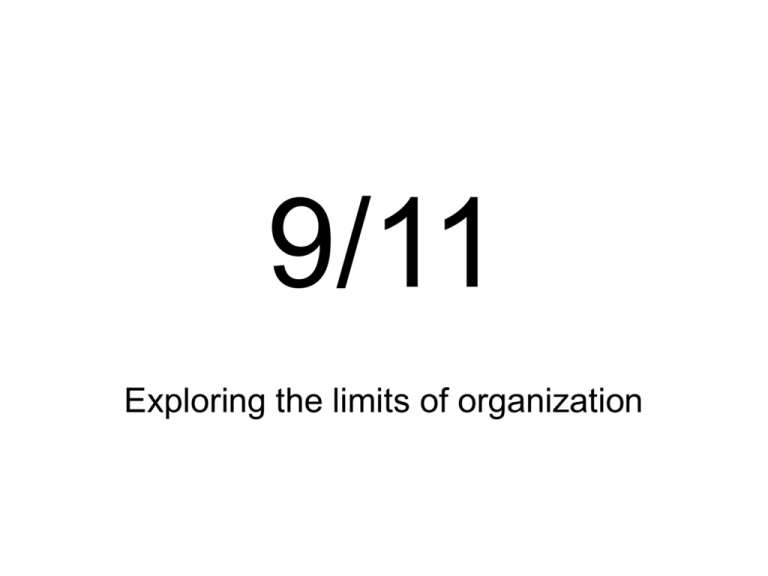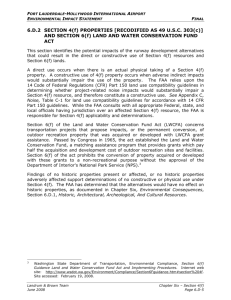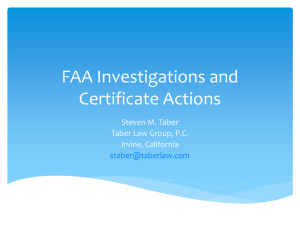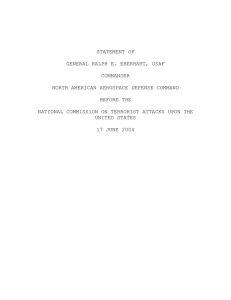studier/program/esst-master/undervisningsmateriale/Module 4/9 11
advertisement

9/11 Exploring the limits of organization The highjacking • Four long range domestic flights – American Airlines Flight 11 – Boston to LA – United Airlines Flight 175 – Boston to LA – American Airlines Flight 77 – Washingt. to LA – United Airlines Flight 93 – Newark to SF • 4 – 5 persons, prior flight training • Take control using knives, teargas, threats • Turn of tracking device - transponder The defense system • Air control: – Federal Aviation Administration (FAA) • Military Air Defense: – North American Aerospace Defense Command (NORAD) • The President / Government Federal Aviation Administration FAA • Responsible for regulating safety and security of civil aviation • Primary task: maintaining a safe distance between airborne aircraft Federal Aviation Administration FAA • 22 Control Centers – regions – Receive information and make operational decisions independently • 1 Command Center – national control – Operations Center North American Aerospace Defense Command (NORAD) • Responsible for defending the airspace in North America and protecting the continent • After cold war: new role • Some exercise on terror attacks but never on domestic aircraft and not as guided missiles North American Aerospace Defense Command (NORAD) • 7 alert sites with 2 fighter aircraft on alert • 3 sectors • On 9/11 all aircraft were in Northeast Air Defense Sector (NEADS) • NEADS reports to CONR, CONR to NORAD • 2 alert sites relevant – Otis Air National Guard Base in Cape Cod – Langly Air Force Base in Hampton Virginia National Guard troops stationed at NORAD's Northeast Air Defense Sector (NEADS) in Rome, New York. Interagency Collaboration • Hijack protocol FAA and NORAD – Pilots notify controller – Controller notify supervisors – Supervisors inform Control Center management – Manager inform FAA headquarters in Washington – Hijack coordinator: director of FAA Office of Civil Aviation Security Interagency Collaboration • Hijack protocol FAA and NORAD – FAA Highjack coordinator contacts Pentagon to ask for military escort aircraft – Pentagon seek approval from Secretary of Defense – If approved orders transmitted down NORADS chain of command – Pentagon help FAA coordinate with military Interagency Collaboration • Hijack protocol FAA and NORAD – Did not have instructions for interception – Fighter aircraft mission: “vectored to a position five miles directly behind the hijacked aircraft” Interagency Collaboration • Protocol assumptions: – Hijacked aircraft readily identifiable and would not disappear – Time to address the problem through proper chains of command – The hijacking would aim at landing the aircraft and placing demands Interagency Collaboration • On the morning of 9/11, the existing protocol was unsuited in every respect for what was about to happen. Flight controller Matt McCluskey stands in the Boston tower where the Flight 11 hijack was first detected American Airlines Flight 11 • Chain of command not followed • FAA did not contact NORAD through chain of command • Lack of information coordination between FAA and military United Airlines Flight 175 • Unnoticed disappearance because of AA 11 • No military notification American Airlines Flight 77 • • • • First thought to have crashed Disappeared Was then found by Dulles Control Center FAA never reported to the military before crash • FAA did not ask for military assistance Confusion arises • At 9:21 FAA misinforms NEADS (NORAD) about the number of aircraft • NEADS acts on the confusion that American 11 was still airborne and heading towards Washington • NEADS scrambles Langley to intercept this “phantom aircraft” Confusion arises Confusion arises Confusion arises • 9: 34 NEADS contacts FAA to find out about American 11 (had crashed 8:46) • Learns about American 77 Confusion arises Confusion arises • FAA Boston Center guessed that Delta 1989 might be hijacked and heading south • NEADS orderd figher aircraft from Ohio and Michigan to intercept United Airlines Flight 93 • Chain of command followed fast from Cleveland Center through FAA headquarters (2 min.) • FAA had established and open line between centers and the Command Center • However, FAA did not seek military assistance • NEADS informed after crash United Airlines Flight 93 United Airlines Flight 93 National leadership • President away • No serious attention before United 175 hit 2 WTC • FAA and Department of Defense teleconference. No impact. • White House video teleconference including CIA, FBI, DoS, Justice, Defense, FAA, White House Shelter. National leadership • National Military Command Center (NMCC) • Establish the chain of command from National Command Authority (President and secretary of Defense) and those executing orders. • Problematic teleconferences between top agencies. National leadership • No success in coordinating information and decisions between the top level organizations – FAA – NORAD – NMCC – National Command Authority • Direct contacts between Secret Service and FAA Vice President Cheney pointing a finger inside the Presidential Emergency Operations Center. Footage of the World Trade Center plays on the televisions in the background (exact time is unknown). The shoot down order • Unclear when the order was given from the Vice President from the White House shelter. • Confusion within NORAD on the nature of the order • Orders not passed on to the operational level – the pilots. The Andrews fighters • Through direct contact between Secret Service agents and the commander of the 113th Wing fighters were launched from Andrews Air Force Base at 10:38 • Orders: weapons free • Scrambled outside military chain of command. • Not known by President and Vice President. • “The details of what happened on the morning of September 11 are complex, but they play out a simple theme. NORAD and FAA were unprepared for the type of attacks launched against the United States on September 11, 2001. They struggled, under difficult circumstances, to improvise a homeland defense against an unprecedented challenge they had never before encountered and had never trained to meet.” What is this a case of? • The weakness of established routines in unexpected circumstances • How human mistakes creates chains of interdependent failure • The problems of coordinating between large organizations that rarely operate together on a daily basis • The impact of an extremely tight schedule



